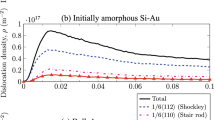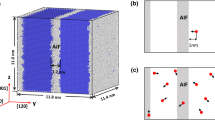Abstract
Interfaces act as obstacles to slip and sinks for radiation-induced defects. Hence, nanolayered composites that contain a large volume fraction of interfaces provide over an order of magnitude increase in strength and enhanced radiation damage tolerance compared to bulk materials. This paper shows the experimental and atomistic modeling results from a Cu-Nb nanolayered composite to highlight the roles of nanostructuring length scales and the response of interfaces to ion collision cascades in designing composite materials with high radiation damage tolerance.
Similar content being viewed by others
References
BES Workshop report Basic Research Needs for Advanced Nuclear Energy Systems, www.science.doe.gov/bes/reports/files/ANES_rpt.pdf.
A. Misra, H. Kung, and R.G. Hoagland, Philos. Mag., 84 (2004), p. 1021.
T. Hochbauer et al., J. Appl. Phys., 98 (2005), p. 123516.
M.J. Demkowicz et al., Nucl. Instru. Methods B, 261 (2007) p. 524.
X. Zhang et al., Nucl. Instru. Methods B, 261 (2007) p. 1129.
K. Hattar et al., Appl. Phys. Lett. (submitted).
M.S. Daw and M.I. Baskes, Physical Review B, 29 (1984), p. 6443.
Y. Mishin et al., Physical Review B (Condensed Matter and Materials Physics), 63 (2001), p. 224106.
R.A. Johnson and D.J. Oh, Journal of Materials Research, 4 (1989), p. 1195.
M.J. Demkowicz and R.G. Hoagland, J. Nuc. Mater. (in press).
J.F. Ziegler, J.P. Biersack, and U. Littmark, The Stopping and Range of Ions in Solids (New York: Pergamon, 1985).
K.T. Kuwata, R.I. Erickson, and J.R. Doyle, Nuclear Instruments & Methods in Physics Research Section B-Beam Interactions with Materials and Atoms, 201 (2003), p. 566.
P.M. Anderson et al., Acta Materialia, 51 (2003), p. 6059.
G.J. Dienes and G.H. Vineyard, Radiation Effects in Solids (New York: Interscience Publishers, 1957).
A. Misra, J.P. Hirth, and R.G. Hoagland, Acta Materialia, 53 (2005), p. 4817.
N. Nita et al., Philos. Mag., 85 (2005), p. 723.
M. Samaras et al., Phys. Rev. Lett., 88 (2002), p. 125505.
M. Rose, A.G. Balogh, and H. Hahn, Nucl. Instru. Methods B, 127/128 (1997), p. 119.
H.L. Hienisch, F. Gao, and R.J. Kurtz, J. Nucl. Mater., 329–333 (2004), p. 924.
Author information
Authors and Affiliations
Corresponding author
Rights and permissions
About this article
Cite this article
Misra, A., Demkowicz, M.J., Zhang, X. et al. The radiation damage tolerance of ultra-high strength nanolayered composites. JOM 59, 62–65 (2007). https://doi.org/10.1007/s11837-007-0120-6
Published:
Issue Date:
DOI: https://doi.org/10.1007/s11837-007-0120-6




